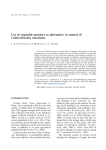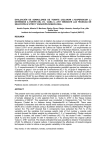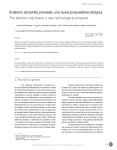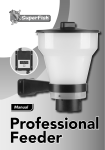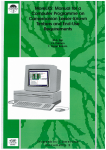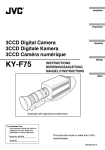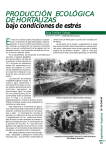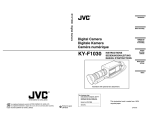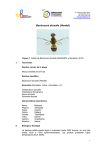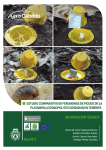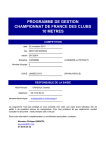Download Plant secondary metabolites as alternatives in pest
Transcript
Rev. Protección Veg. Vol. 28 No. 2 (2013): 95-108 REVIEW ARTICLE Plant secondary metabolites as alternatives in pest management. II: An overview of their potential in Cuba Oriela Pino, Yaíma Sánchez, Miriam M. Rojas Grupo de Plagas Agrícolas, Dirección de Sanidad Vegetal, Centro Nacional de Sanidad Agropecuaria (CENSA), Apartado 10, San José de las Lajas, Mayabeque, Cuba. Teléfono: 863014 ext-148 Correo electrónico: [email protected] ABSTRACT: This review covers the historical use of plant secondary metabolites in agricultural practices in Cuba and their potential in pest management. The Cuban flora has not yet been fully studied as a source of pesticides, partly due to its great diversity. Nevertheless, up to date, several plants are used by Cuban farmers as repellents and/or as raw material for the preparation of botanical pesticides in an artisan manner, and more than 60 plants have demonstrated their pesticidal activity under laboratory, semicontrolled and field conditions. Meliaceae, Asteraceae, Fabaceae, Solanaceae, Clusiaceae, Piperaceae, Lamiaceae, Apiaceae, and Mirtaceae are among the most important involved plant families. From the chemical point of view, promising results have been achieved with alkaloids, terpenoids, coumarins and essential oils. The efficient practical application of pesticidal properties of plants in crop rotation, polycrops, and intercropping, and as barrier or traps requires further research from the chemical ecology point of view. As botanical pesticides, plant secondary metabolites may be applied in protected crops, nurseries, seed treatments in protected and field-grown crops, storage pest management among others. Innovative products can be developed by using them in mixtures with other phytosanitary products and as resistance inducers. The use of known botanicals and the identification of local candidates for developing new products offer alternatives that may combine efficiency and safety for the Cuban agriculture in pest management. Multidisciplinary and multiinstitucional research-development, and innovation programmes will play an important role in the increase of the scientific and socioeconomic impact of these phytosanitary products for contributing to a sustainable food production. Key words: Cuban flora, botanical pesticides, pest management, secondary metabolites. Metabolitos secundarios de origen botánico como alternativas en el manejo de plagas. II: Visión general de su potencial en Cuba RESUMEN: Esta revisión abarca el uso histórico de los metabolitos secundarios de origen botánico en prácticas agrícolas y su potencial en el manejo de plagas en Cuba. La flora cubana aún no se ha estudiado totalmente como fuente de plaguicidas, en parte debido a su gran diversidad. Sin embargo, hasta la fecha, numerosas plantas son utilizadas por los campesinos cubanos como repelentes y/o materia prima para la preparación de extractos de manera artesanal y se ha demostrado la actividad plaguicida de más de 60 plantas en condiciones de laboratorio, semicontroladas y campo. Entre las familias botánicas involucradas más importantes se encuentran: Meliaceae, Asteraceae, Fabaceae, Solanaceae, Clusiaceae, Piperaceae, Lamiaceae, Apiaceae y Mirtaceae. Desde el punto de vista químico, se han logrado resultados promisorios con alcaloides, terpenoides, cumarinas y aceites esenciales. La aplicación práctica eficiente de las propiedades plaguicidas de las plantas en la rotación, asociación y el intercalamiento de cultivos y como barreras y trampas requiere de la ejecución de investigaciones desde el punto de vista de la ecología química. Como plaguicidas botánicos se pueden aplicar en cultivos protegidos, viveros, tratamientos de semillas, manejo de plagas de almacén; entre otros. Productos novedosos se pueden desarrollar utilizando metabolitos secundarios en mezclas con otros productos fitosanitarios y como inductores de resistencia. El uso de extractos vegetales conocidos y la identificación de candidatos locales para el desarrollo de nuevos productos, ofrecen alternativas que pueden combinar eficiencia y seguridad en el manejo de plagas en la agricultura cubana. Programas de investigación-desarrollo e innovación multidisciplinarios y multiinstitucionales desempeñarán un rol importante en el incremento del impacto científico y socioeconómico de estos productos fitosanitarios para contribuir a una producción sostenible de alimentos. Palabras clave: flora cubana, plaguicidas botánicos, manejo de plagas, metabolitos secundarios. 96 INTRODUCTION In Cuba, the search for new alternatives for pest management is a first priority task in agricultural sciences to reduce economic losses in crops, pest resistence development and the agroecosystem pollution (1, 2). The country is engaged in developing a model of agriculture where biopesticides (microorganisms, macroorganisms and botanicals) play a key role in obtaining good yields with a high ecological value in a sustainable food production (1, 2, 3, 4, 5). In order to ensure the practical achievement of such objectives, the Integrated Pest Management was adopted as a policy of the Cuban State since the eighties; and in 1988, the National Programme for the Production of Biopesticides established their use within the Cuban strategy devised for a sustainable agricultural production (1, 2, 3, 6, 7). In 1997, the Cuban Goverment policy was officially stated in the Law of Environment (8). The ninth title of this law, «Rules for a Sustainable Agriculture», Article 132, subsections b and d, in relation with pest management, expresses: b) the rational use of biological and chemical products, according to the characteristics, conditions and local resources that minimize environment pollution, d) preventive and integrated management of pests, with special attention to the use of biodiversity resources for these purposes. The National Environmental Strategy 2007-2010, approved by the Ministry of Science, Technology and Environment (CITMA), established as goal that «80% of pest and disease control in crops in the country must be done using natural products or biopesticides» and that «100% of the areas of agricultural production must be maintained under integrated pest management schemes» (5, 9). On this basis in many crops, the use of biological products (botanicals in a lesser proportion) makes an important contribution to the reduction of the presence of the main pests, the costs of importing large amounts of synthetic pesticides and their polluting effects in agroecosystems (2, 3). During the last 20 years, several changes in pest management led to reduce the national use of pesticides in more than 50% (3, 4). Tropical plants, which grow under climatic conditions favouring microbial or insect attack, have developed a great variety of defence molecules. They constitute therefore a particularly rich source of substances which can find an application, directly or as lead compounds, for the development of new pest control agents (10, 11). It is thus highly likely that safe, efficient new molecules with new modes of action will find a place in agriculture for many decades to come (12). Rev. Protección Veg. Vol. 28 No. 2 (2013) Cuba is considered as one of the most biodiverse countries in the world in terms of sheer numbers of species and has the richest plant biodiversity of all the islands in America, with an estimated 6,500 vascular plant species of which 50% are endemic (6, 13). Partly due to its great diversity, the Cuban flora has not yet been closely studied as a potential source of chemical pesticides (13, 14, 15, 16). To date, only a small fraction of the plant species has undergone systematic phytochemical or biochemical research, leaving valuable sources for commercial products undiscovered (13). This review covers the historical use of plant secondary metabolites in agricultural practices, and their potential in pest management in Cuba. Historical use of plant secondary metabolites in agricultural practices and current researches in Cuba There are many anecdotes of the biological activity of several Cuban plants and their popular use as natural pharmaceuticals and pesticides, but the active compounds have not been studied in most cases. Also, the available information is often only related to botanical data, medicinal use and for some plants it dates back to many years (15, 17). Nicotine, rotenone, and pyrethrins, contained in extracts from plants belonging to Nicotiana, Tephrosia and Chrysanthemum genera, can be mentioned among the best known natural pesticides in Cuba since the 1940s. A common practice was the use of aqueous extracts made from tobacco crop residues or other botanical species to spray them over the crops for insect control; stored grains (for food and seed) were also protected using tobacco powder (1). Cuban farmers use several plants as repellents and/ or as raw material for the preparation of botanical pesticides in an artisan manner (Table 1) (2, 18). These plants are maintened in borders, live fences, gardens, organoponics, intensive orchards and farms, standing out Ocimum basilicum L. (basil), Tagetes erecta L. (African marigold), Azadirachta indica A. Juss (neem), Origanum vulgare L. (origanum) and Euphorbia lactea Haw. (Mottled Spurge, Frilled Fan or Elkhorn) as the most frequently reported (18, 19). Ethnobotanical studies have shown that there is a level of plant biodiversity in urban agriculture and small farms which are used by the farmers, but the capacity building and dissemination actions about their use and pest control properties, as well as the search of alternatives for in situ conservation must be increased (2, 19). The effects of some of these plants have not been validated with scientific rigour in our conditions and it is a disadvantage for recommending their use (21). 97 TABLE 1. Some plants with pesticidal properties used by Cuban farmers./ Algunas plantas con propiedades plaguicidas utilizadas por los agricultores cubanos. Plant (Scientific name) Achillea millefolium L. Agave sobolifera Salm. Dyck Allium cepa L. Allium sativus L. Aloe barbadensis Mill. Annona cherimolia Mill. Annona muricata L. Annona squamosa L. Artemisia abrotanum L. Artemisia absinthium L. Asclepia curassavica L. Asparagus officinalis L. Azadirachta indica A. Juss. Bixa orellana L. Brassica oleracea L. Bursera graveolens H.B.K. Triana Planch. Bursera simaruba Sarg. Calendula officinalis L. Canavalia ensiformis (L.). P.D.C Capsicum frutescens L. Carica papaya L. Chenopodium ambrosiodes L. Chrysanthemum sp. Cinnamomum camphora L. (Siebold) Coriandrum sativum L. Crescentia cujete L. Cymbopogon citratus (D.C) Stapf. Cymbopogon nardus L. Datura arborea L. Dichrostachys cinerea (L.) Wigth. Eucalyptus sp. Euphorbia lactea Haw. Equisetum bogotense Kunth Foeniculum vulgare Mill. Gliricidea sepium (Jacq) Steud. Guazuma tomentosa H.B.K Helianthus annuus L. Jatropha curcas L. Lactuca sativa L. Lantana camara L. Lepidium virginium L. Matricaria recutita L. Melia azedarach L. Mentha arvensis L. Mentha nemorosa Willd. Mentha piperita L. Moringa oleifera Lam. Nerium oleander L. Nicotiana tabacum L. Repellent X X Plant extracts X X X X X X X X X X X X X X X X X X X X X X X X X X X X X X X X X X X X X X X X X X X X X X X X X X X X x X X X X X X X X X X X X X Reference 20 19, 20 18, 19, 20 18, 19, 20 19 19, 20 19, 20 19, 20 20 19 19, 20 19 18, 19 19 19 19 19, 20 18, 19 19 19, 20 18, 19, 20 19, 20 19, 20 19, 20 19 19 19, 20 20 19 19 19, 20 19, 20 18 19 19 19, 20 19 19, 20 19, 20 20 19 18, 19, 20 18, 19, 20 19, 20 19 19, 20 19 19, 20 18, 19 Rev. Protección Veg. Vol. 28 No. 2 (2013) 98 TABLE 1. Continuation. Some plants with pesticidal properties used by Cuban farmers./ Continuación. Algunas plantas con propiedades plaguicidas utilizadas por los agricultores cubanos. Plant (Scientific name) Nopalea coccinellifera (L.) Salm.- Dyck. Ocimum basilicum L. Origanum vulgare L. Parthenium hysterophorus L. Petiveria alliacea L. Pinus caribaea Morelet. Piper auritum H.B.K Pouteria mammosa (L) Cronquist Raphanus sativus L. Ricinus communis L. Rosmarinus officinalis L. Ruta graveolens L. Salvia officinalis L. Sesamum orientale L. Solanum globiferum Dunal. Solanum mammosum L. Solanum licopersicon Mill. Sorghum vulgare Pers. Tagetes erecta L. Tagetes patula L. Tephrosia cinerea (L) Pers. Thymus vulgaris L. Urtica urens L. Vallesia antillana Woodson. Vetiveria zizanioides (L.) Nash. Zea mays L. Considering the influence of the whole plant diversity on insect pests and natural enemies, some studies have been addressed to establish the effects of the direct sowing (22) and the polycrops (23, 24, 25) on the entomophauna. The results showed that the diversity in the crop systems (achieved by direct sowing of the plant and the polycrops) reduced the incidence of the insect pests (22, 23, 24, 25) and increased the species richness of bioregulators (23). The potential role of the plant secondary metabolites in these interactions has not been established and further research from the chemical ecology point of view should be done in the frame of future multidisciplinary projects. Endemic and exotic species in the Cuban flora are potential sources of substances with regulatory effect on populations of harmful organisms, but the real possibility of including natural products extracted from plants into national programmes was not considered until the end of the eighties and early nineties, when several research projects on this subject were initiated (2, 7). Currently, several Cuban research institutes and Rev. Protección Veg. Vol. 28 No. 2 (2013) Repellent X X X X X X X X X X X X X X X X Plant extracts X X X X X X X X X X X X X X X X X X X X X X Reference 19, 20 19 19 19 19 19, 20 19 19, 20 19 18, 19, 20 19, 20 18, 19, 20 19 19 19, 20 19, 20 19 19 19, 20 20 19 19 18 19, 20 19 19 universities develope research lines related to bioactive secondary metabolites with potential application in agriculture. Table 2 summarises the information of some plants with a scientific description of their biological effectiveness published in the main Cuban journals related to this topic (2). According to Alfonso et al. (6), the biological activity of 52 species belonging to 30 botanical families was reported until 2002. Considering both the number of species tested with positive results and the bioactivity spectrum, the Meliaceae, Asteraceae, Fabaceae, and Solanaceae were among the most important families. The most significant species were the neem tree, the chinaberry (Melia azedarach L.), the love apple (Solanum mammosum L) and the French marigold (Tagetes patula L.) (2, 7, 69). Other botanical pesticides have been prepared from M. azedarach (MELITOX 50, PARAISO-M), Chrysanthemum cinense Sabine, Tagetes erecta L, Solanum globiferum Dunal (SOLASOL), Gliricidia sepium J. (GLISEP 60) and Indigofera suffruticosa Mill (16, 18). 99 TABLE 2. Some Cuban plants with pesticidal activity determined under laboratory, semicontrolled and field conditions./ Algunas plantas cubanas con actividad plaguicida determinada en condiciones de laboratorio, semicontroladas y campo. Plant (Scientific name) Allium porrum L Allium sativum L. Azadirachta indica A. Juss Bixa orellana L. Extract, product powder aqueous extract CubaNim SM CubaNim T CubaNim T CubaNim T FoliarNim HM formulated oil NeoNim 60 CE NeoNim 60 CE NeoNim 60 CE OleoNim 50 CE OleoNim 80 CE OleoNim 80 CE OleoNim 80 CE OleoNim 80 CE OleoNim 80 CE OleoNim 80 CE powder methanolic extract methanolic extract methanolic extract Bougainvillea spectabilis Willd Canavalia ensiformis (L.). P.D.C Canna edulis Ker Carica papaya L. Chenopodium ambrosioides L Citrus sinensis (L.) Osbeck Cleome gynandra L. Cleome viscosa L. Coleus amboinicus Lour Crescentia cujete L. Curcuma longa L. Cymbopogon citratus (DC.) Stapf Cymbopogon nardus L. methanolic extract aqueous extract aqueous extract powder aqueous extract aqueous extract Target Pest Zabrotes subfasciatus (Boheman) Carolinaia cyperi Ainslie Thrips palmi Karmy Bemisia tabaci Genn Empoasca fabae Hans Thrips palmi Karmy Thrips palmi Karmy Praticolella griseola Pfeiffer Diaphania hyalinata L. Empoasca fabae Hans Thrips palmi Karmy Heliothis virescens F. Bemisia tabaci Genn Diaphania hyalinata L. Empoasca fabae Hans Heliothis virescens F. Hypsipyla grandella Zeller Thrips palmi Karmy Zabrotes subfasciatus (Boheman) Xanthomonas axonopodis pv. manihotis (Xam) Xanthomonas axonopodis pv. vesicatoria Vauterin et al. Xanthomonas campestris pv. campestris (Pammel) Dawson Xanthomonas sp. Sugar cane mosaic virus (SCMV) Severe Cowpea Mosaic Virus (CpSMV) Sitophilus zeamais Motschulsky Biological activity repellent insecticidal antiinsect antiinsect antiinsect antiinsect antiinsect molusquicidal antiinsect antiinsect antiinsect insecticidal antiinsect antiinsect antiinsect insecticidal insecticidal antiinsect repellent antibacterial Reference 26 27 29 29 29 29 29 28 29 29 29 30 29 29 29 30 21 29 26 31 antibacterial 31 antibacterial 31 antibacterial antiviral resistence inducer 31 32 33 repellent, insecticidal molusquicidal resistence inducer 34 repellent 26 powder Praticolella griseola Pfeiffer Severe Cowpea Mosaic Virus (CpSMV) Zabrotes subfasciatus (Boheman) essential oil Alternaria solani Sor. antifungal 35 ethanolic extract ethanolic extract ethanolic extract aqueous extract aqueous extract aqueous extract aqueous extract* Alternaria solani Sor. Alternaria solani Sor. Alternaria solani Sor. Fusarium oxysporum Slecht. Rhizoctonia solani (Kühn) Fusarium oxysporum Slecht. Mycosphaerella fijiensis Morelet. antifungal antifungal antifungal antifungal antifungal antifungal antifungal 36 36 36 14 14 14 37 essential oil Macrophomina phaseolina (Tassi) Goid Rhizoctonia solani (Kühn) antifungal 38 fungicide 39 citronellal 28 33 Rev. Protección Veg. Vol. 28 No. 2 (2013) 100 TABLE 2. Continuation. Some Cuban plants with pesticidal activity determined under laboratory, semicontrolled and field conditions./ Continuación. Algunas plantas cubanas con actividad plaguicida determinada en condiciones de laboratorio, semicontroladas y campo. Plant (Scientific name) Furcraea hexapetala (Jacq.) Urban Gliricidia sepium (Jaq.) Steud Extract, product aqueous extract Target Pest Polyphagotarsonemus latus Banks Biological activity antimite aqueous extract aqueous extract insecticidal antifungal 41 41 antinematode insecticidal insecticidal antifungal 41 41 41 42 antifungal molusquicidal molusquicidal antifungal antifungal 14 28 28 16 42, 43 aqueous extract Blatella germanica L. Corynespora cassiicola (Berk and Curt) Wei Meloidogyne spp. Pieris ph. phileta Bdy Plutella xylostella L. Corynespora cassiicola (Berk and Curt) Wei Fusarium oxysporum Slecht. Praticolella griseola Pfeiffer Praticolella griseola Pfeiffer Botrytis cinerea Pers.:Fr. Corynespora cassiicola (Berk and Curt) Wei Meloidogyne incognita (Kofoid and White) Chitwood Spodoptera frugiperda Smith ethanolic extract ethanolic extract ethanolic extract Alternaria solani Sor. Alternaria solani Sor. Alternaria solani Sor. ethanolic extract powder Alternaria solani Sor. Sitophilus zeamais Motschulsky organic extract organic extract organic extract aqueous extract aqueous extract aqueous extract aqueous extract Helianthus annuus L. Jatropha curcas L. Juniperus lucayana B. Lantana camara L. aqueous extract ethanolic extract formulated oil ethanolic extract aqueous extract aqueous extract Lippia alba (Mill.) N.E. Brown Lippia dulcis Trev. Lonchocarpus punctatus L. Mammea americana L. Maytenus urquiolae Mory Melaleuca quinquenervia (Cav) S.T. Blake nematicidal 43 antifeedant, insecticidal antifungal antifungal antifungal 43 36 44 Phaedon cochleariae Fab. Tetranychus urticae Koch Curvularia clavata B. L. Jain antifungal repellent, insecticidal insecticidal acaricidal fungicide 45, 46 45 47 essential oil essential oil Alternaria solani Sor. Alternaria solani Sor. antifungal antifungal 35 48 essential oil Clavibacter michiganensis subsp. michiganensis (Smith) Davis et al. Panonychus citri McGregor Raoiella indica Hirst Tetranychus tumidus Banks Tetranychus urticae Koch Xanthomonas albilineans (Ashby) Dawson Carolinaia cyperi Ainslie Mocis latipes (Guenee) Praticolella griseola Pfeiffer Rhyzopertha dominica (F.) Mycosphaerella fijiensis Morelet. Fusarium oxysporum Slecht. Rhizoctonia solani (Kühn) antibacterial 48 antimite antimite antimite antimite antibacterial 48 48 48 48 48 insecticidal insecticidal molusquicidal insecticidal antifungal antifungal antifungal 27 16 28 49 37 14 14 essential oil essential oil essential oil essential oil essential oil Melia azedarach L. Momordica charantia L. Reference 40 aqueous extract ethanolic extract formulated oil powder aqueous extract* aqueous extract aqueous extract Rev. Protección Veg. Vol. 28 No. 2 (2013) 36 36 36 101 TABLE 2. Continuation. Some Cuban plants with pesticidal activity determined under laboratory, semicontrolled and field conditions./ Continuación. Algunas plantas cubanas con actividad plaguicida determinada en condiciones de laboratorio, semicontroladas y campo. Plant (Scientific name) Muralla paniculata L. Nicotiana tabacum L. Extract, product aqueous extract aqueous extract aqueous extract tabaquina Ocimum basilicum L. essential oil essential oil essential oil Ocimum basilicum var genovese L. essential oil essential oil essential oil Parthenium hysterosphorus L. Pimpinella anisum L. powder Piper aduncum subsp. ossanum (C. DC.) Saralegui essential oil essential oil essential oil essential oil essential oil Piper auritum Kunth essential oil essential oil essential oil essential oil Piper marginatum Jacq. powder essential oil essential oil essential oil essential oil essential oil Polyscia guilfoyley Bailey Pteridium aquilinum (L.) Kunth Ricinus communis L. aqueous extract aqueous extract ethanolic extract aqueous extract aqueous extract aqueous extract aqueous extract Target Pest Fusarium oxysporum Slecht. Carolinaia cyperi Ainslie Rhizoctonia solani (Kühn) Whiteflies, Thrips palmi and other insects Alternaria solani Sor. Clavibacter michiganensis subsp michiganensis (Smith) Davis et al. Xanthomonas albilineans (Ashby) Dawson Alternaria solani Sor. Clavibacter michiganensis subsp. michiganensis (Smith) Davis et al. Xanthomonas albilineans (Ashby) Dawson Zabrotes subfasciatus (Boheman) Alternaria solani Sor. Xanthomonas campestris pv. vesicatoria Doidge (Dye) Alternaria solani Sor Lasioderma serricorne (F.) Xanthomonas albilineans (Ashby) Dawson Acidovorax avenae subsp. avenae (Manns) Willems et al. Alternaria solani Sor. Xanthomonas albilineans (Ashby) Dawson Xanthomonas albilineans (Ashby) Dawson Zabrotes subfasciatus (Boheman) Alternaria solani Sor. Alternaria solani Sor. Xanthomonas albilineans (Ashby) Dawson Xanthomonas albilineans (Ashby) Dawson Xanthomonas campestris pv. campestris (Pammel) Dawson Fusarium oxysporum Slecht. Rhizoctonia solani (Kühn) Alternaria solani Sor. Ascia monuste L. Brevicoryne brassicae L. Plutella xylostella L. Hipothenemus hampei Ferr Biological activity antifungal insecticidal antifungal insecticidal Reference 14 27 14 50 antifungal antibacterial 35 51 antibacterial 51 antifungal antibacterial 35 51 antibacterial 51 repellent 26 antifungal antibacterial 35 52 antifungal repellent, insecticidal antibacterial 35 53 antibacterial 55 antifungal antibacterial 35 55 antibacterial 54 repellent antifungal antifungal antibacterial 26 35 56 56 antibacterial 57 antibacterial 56 antifungal antifungal antifungal insecticidal insecticidal insecticidal insecticidal 14 14 36 58 58 58 59 54 Rev. Protección Veg. Vol. 28 No. 2 (2013) 102 TABLE 2. Continuation. Some Cuban plants with pesticidal activity determined under laboratory, semicontrolled and field conditions./ Continuación. Algunas plantas cubanas con actividad plaguicida determinada en condiciones de laboratorio, semicontroladas y campo. Plant (Scientific name) Rosmarinus officinalis L. Ruta chalepensis L. Salvia officinalis L. Solanum globiferum Dunal Solanum mammosum L. Stachytarpheta jamaisense Gard. Tagetes erecta L. Terminalia catappa L. Thuja orientalis L. Tithonia diversifolia (Hemsl.) Gray Tradescantia pallida (Rose) D.R. Hunt Tradescantia spathacea Sw. Trichila glabra L. Wedelia trilobata (L.) Hitchc Zea mays L. Legend: * 90ml aq extract Extract, product essential oil essential oil aqueous extract* powder aqueous extract aqueous extract aqueous extract ethanolic extract ethanolic extract ethanolic extract ethanolic extract aqueous extract aqueous extract aqueous extract Target Pest Tetranychus tumidus Banks Alternaria solani Sor. Mycosphaerella fijiensis Morelet. Zabrotes subfasciatus (Boheman) Severe Cowpea Mosaic Virus (CpSMV) Praticolella griseola Pfeiffer Succinia sagra d'Orbigny Praticolella griseola Pfeiffer Succinia sagra d'Orbigny Praticolella griseola Pfeiffer Succinia sagra d'Orbigny Sclerotiun rolfsii Sacc. ethanolic extract ethanolic extract ethanolic extract ethanolic extract aqueous extract aqueous extract aqueous extract ethanolic extract ethanolic extract ethanolic extract powder Rhizoctonia solani (Kühn) Severe Cowpea Mosaic Virus (CpSMV) Alternaria porri Ell. and Cif. Alternaria solani Sor. Cercospora beticola Sacc. Cladosporium fulvum Cooke Rhizoctonia solani (Kühn) Rhizoctonia solani (Kühn) Sclerotiun rolfsii Sacc. Botrytis cinerea Pers.:Fr. Mocis latipes (Guenee) Alternaria solani Sor. Sitophilus zeamais Motschulsky ethanolic extract Biological activity acaricidal antifungal antifungal repellent resistence inducer Reference 60 35 37 26 33 molusquicidal molusquicidal molusquicidal molusquicidal molusquicidal molusquicidal antifungal 28 28 28 28 28 28 61 antifungal resistence inducer 62 33 63 63 63 63 62 64 64,65 16 16 36 66 Alternaria solani Sor. antifungal antifungal antifungal antifungal antifungal antifungal antifungal antifungal insecticidal antifungal repellent, insecticidal antifungal ethanolic extract Alternaria solani Sor. antifungal 36 aqueous extract aqueous extract Rhizoctonia solani (Kühn) Sclerotiun rolfsii Sacc. antifungal antifungal 14 67 aqueous extract +10ml aceite Nim Panonychus citri McGregor antimite 68 In 1990, the agroindustrial development of neembased pesticides was begun in Cuba; this multidisciplinary research programme included the widespread cultivation and production of bio-insecticides, veterinary, and industrial products (1). The project for the industrial development of neem and chinaberry as a second line considered 15 microforests (12 ha each, six of neem and six of chinaberry), four semiindustrial Rev. Protección Veg. Vol. 28 No. 2 (2013) 36 processing plants (capacity of 200 t.year-1) and a pilot plant for the industrial production (7). The plantations were established in order to obtain natural products for agricultural use in addition to contribute to recover unproductive marginal land, increase the biomass and consequently improve the ecological environment (1). Till now, research results have shown that the Cuban natural products based on neem are effective in 103 regulating insects, mites, nematodes, and molluscs that affect a large number of economically important crops for our agriculture (vegetables, rice, tomato, corn and beans) (1, 26, 28, 29, 30). Another advantage of using neem extracts is their possible production in an artisan way (7). Up to date, the following neem- based commercial products have been developed: CubaNim Sm (whole seed aqueous extract), CubaNim-t (cake aqueous extract), FoliarNim HM (leaf aqueous extract), CubaNim SM (whole grounded seed), CubaNim T (oilcake), OleoNim 80 EC and NeoNim 60 EC (seed oil emulsions), and DerNim P (cream to treat scabies) (1). The last five products are in the Official List of Authorized Pesticides in the Republic of Cuba (70) As a result of the problems caused by whiteflies in 1989-1990, simple technologies were developed to extract nicotine from parts of leaves considered waste of the tobacco industry (7, 50). Then the product known as «tabaquina» arose, which is now widely used in the country (2). It is obtained by farmers and agricultural cooperatives and has been used to control whitefly, thrips, and other pests (18, 50). The tabaquina shows insecticidal activity and its residual effect is four days (7). During the last years, the systematic research of more than 100 plants belonging to several botanical families, such as Clusiaceae (genera Calophyllum, Clusia, Mammea, and Rheedia) (13, 45, 46), Piperaceae (Piper, Lepianthes) (35, 53, 54, 55, 56, 71), Lamiaceae (Ocimum) (35, 51), Annonaceae (Annona) (13), Asteraceae (Lescaillea, Vernonia) (13), Myrtaceae (Psidium, Melaleuca) (35, 48), and Poaceae (Arthrostilidium, Zea) (13, 68), have evolved using a chemotaxonomic approach. The protocol involves the establishment of bioassay conditions, the isolation and characterisation of new bioactive compounds, the determination of structural features related to biological activity, and the semisynthesis of analogues (using classical or biotechnological techniques) (13,45, 72). In these studies, plants were initially chosen for both their potential applications as botanical pesticides and as lead compounds. Very rare species not previously studied from a chemical or biological point of view (with great possibilities of discovering novel compounds), as well as other abundant species (enough availability of raw material for developing a botanical pesticide) were included. Under laboratory and semicontrolled conditions, promising results have been achieved with coumarins and essential oils obtained from plants belonging to the Clusiaceae, Piperaceae, Lamiaceae, Apiaceae, and Mirtaceae families (Figure) (13, 45,46, 35, 48, 51, 52, 53, 56, 57, 71). FIGURE. Main bioactive compounds identified in organic extracts and essential oils./ Principales compuestos bioactivos identificados en extractos orgánicos y aceites esenciales. Legend: (a) mammea E/BA, (b) mammea E/BB, (c) mammea B/BA, (d ) thymol, (e) piperitone, (f) camphor, (g) safrole. Rev. Protección Veg. Vol. 28 No. 2 (2013) 104 An overview of the work done in the area of research and development of botanical-based pesticides in Cuba during the last years points out that several plants may represent viable sources of alternatives for crop protection (Table 2). More than 60 plants demonstrated their pesticidal activity under laboratory, semicontrolled and field conditions. Meliaceae, Asteraceae, Fabaceae, Solanaceae, Clusiaceae, Piperaceae, Lamiaceae, Apiaceae, and Mirtaceae were among the most important families. has a very high wild abundance), formulation of the active ingredients, scale up of the extraction process, toxicity tests, and the ecotoxicological evaluation must be conducted for commercialising the products and contributing to increase the impact of botanical pesticides on a sustainable food production in Cuba. New research and innovation projects concerning the use of secondary metabolites in pest management must be multidisciplinary and multiinstitutional to improve the scientific and socioeconomic impact of the results. The analysis of all these data allows the selection of promising natural products that may go on to candidates for the development of commercial plant protection products. The identification of candidates developing new phytosanitary products offer new alternatives for the Cuban agriculture in the area of pest management in citrus, sugarcane, vegetables, forestry, and in the control of storage pests (7, 21, 34, 35, 44, 48, 51, 52, 53, 56, 66, 68). In spite of the progress achieved in the scientific screening of the Cuban flora, many plant species have not been studied yet (13, 21). Potential of plant secondary metabolites in pest management In much of the research carried out, the biological evaluation did not go along with studies on the chemical composition and the identification of the main bioactive compounds, which is a very important issue considering the close relationship between both aspects and its role in the reproducibility of biological effects. An analysis of the worldwide trends of the scientific literature on botanicals and essential oils calls attention to this aspect. It emphasises that the lack of chemical characterisation does not allow comparing the results with any previous studies with the same plant species and compromises the reproducibility of the results; this study showed that the average impact factor of papers including chemical data greatly exceeds that of papers lacking them (73). In Cuba, only ¼ of the 66 papers reviewed included the identification of the main compounds in the evaluated samples. Among the secondary metabolites studied by Cuban researches until now, essential oils and their components stand out as a promising group due to their efficacy and spectrum of action (39, 48, 51, 52, 55, 56, 60, 71). Also, the extract concentration that provides the most efficient control has not yet been precisely determined in some experiments. Most experiments have been carried out in laboratory conditions and the biological evaluation under semicontrolled and field conditions is essential for achieving a practical application. For these promising candidates, all the studies related to the raw material cultivation (unless the plant Rev. Protección Veg. Vol. 28 No. 2 (2013) The analysis of the use of several alternatives (biocontrol agents, botanical pesticides, crop rotation, and others) in pest management in the Cuban agriculture led to a group of important recommendations. Regarding plants, it was recommended to study the flora species used as traps and with repellent effect, to continue research on botanical-based products considering the Cuban biodiversity, to extend the use of those most studied (like neem), to consider the potential of other promising plants, and to increase the use of plants with pesticidal properties at a small scale (7). Concerning crop protection, the Cuban agricultural development may be benefited by using whole plants or extracting them through different processes. Plants with pest control properties can be used in crop rotation, polycrops, and intercropping, and as barrier (for example in push-pull strategies for controlling insects), or traps. Further research must be done from the chemical ecology point of view to support an efficient practical application of these alternatives in our agroecosystems. Also the plants, part of them or the residues from their harvesting or industrial proccessing may be applied as green manure for a natural pest management (7, 61). As botanical pesticides, the main areas of application may be found in protected crops, nurseries, seed treatments in protected and field-grown crops, and storage pest management. The combination of plant extracts with other types of plant protection products traditionally used by Cuban farmers can be promoted in a near future; improvement of the effectiveness and/ or stability of some biological control agents, or the reduction of the application frequency and dosis of a chemical synthetic treatment may be some of the advantages of the new combined formulations. Additionally, the potential of plant secondary metabolites as resistance inducers may allow the management of complex phytosanitary problems by using some plant extracts in different agricultural systems. 105 General Comments The Cuban flora has not yet been fully studied as a potential source of pesticides, partly due to its great diversity. Nevertheless, up to date, the use of known botanicals and the identification of local candidates for developing phytosanitary products offer alternatives that may combine efficiency and safety for the Cuban agriculture in pest management. Multidisciplinary and multiinstitucional research, and development and innovation programmes will play an important role in the scientific and socioeconomic impact of these plant protection products for contributing to a sustainable food production. ACKNOWLEDGMENTS We thank Dr. Eduardo Sistachs and Dr. Mayra G. Rodríguez for carefully and helpfully reviewing this manuscript. REFERENCES 1. Estrada Ortiz J, López Díaz MT, Castillo Rodríguez BZ, Díaz Fish V. Potencialidades del uso del Nim y sus bioproductos en la producción agropecuaria ecológica y sostenible. Agricultura Orgánica. 2002;8(3):18-21. 2. Vázquez Moreno LL. La lucha contra las plagas agrícolas en Cuba. De las aplicaciones de plaguicidas químicos por calendario al manejo agroecológico de plagas. Fitosanidad. 2006;10 (3):221-242. 3. Vázquez Moreno LL. Transición del manejo de plagas en la producción agropecuaria en Cuba. Agricultura Orgánica. 2012;18(2):21-25. 4. Figueroa González ZI, Pérez-Consuegra N. Tendencias en el uso de plaguicidas en el municipio Colón, provincia Matanzas. Agricultura Orgánica. 2012;18(2):10-14. 5. Estrategia Ambiental Nacional 2007-2010. Ministerio de Ciencia Tecnología y Medio Ambiente (CITMA). República de Cuba. 2007; 60p. 6. Alfonso M, Avilés R, González N, Cruz X, Villasana R, Rodríguez V, et al. Los plaguicidas botánicos y su importancia en la agricultura orgánica. Agricultura Orgánica. 2002;2:26-30. 7. Pérez N, Vázquez LL. Manejo ecológico de plagas. En: Funes F, García L, Bourque M, Pérez N, Rosset P, editors. Transformando el campo cubano. Asociación Cubana de Técnicos Agrícolas y Forestales (ACTAF), La Habana. 2001;191-224. 8. Ley de Medio Ambiente, Ley No. 81, República de Cuba. (Julio, 1997). 9. Hernández Núñez J, Pérez-Consuegra N. Tendencias en el uso de plaguicidas en Batabanó, provincia Mayabeque. Agricultura Orgánica. 2012;18(1):30-33. 10.Hedin PA, Hollingworth RM, Masler EP, Miyamoto J, Thompson DG. Phytochemicals for Pest Control. Washington DC; 1997. 11.Isman MB. Botanical Insecticides, Deterrents, Repellents and Oils. In: Bharat P. Singh ed. Industrial Crops and Uses. ©CAB International; 2010 p. 433445. 12.Smith K, Evans DA, El-Hiti GA. Role of modern chemistry in sustainable arable crop protection. Phil Trans R Soc B. 2008;363:623-637. 13.Pino O, Jorge F, Leon O, Khambay BPS, BranfordWhite C. Cuban flora as a source of bioactive compounds. The International Journal of Cuban Studies. 2008;1(1):1-9. 14.Puente IM, Allaert K, Herrera IL, Suárez N, Torres GS, Pérez NC, et al. Determinación de la actividad alelopática de extractos vegetales sobre algunos hongos fitopatógenos del suelo. Centro Agricola. 2003;30(1):64-68. 15.Rodríguez Y, Fuentes JE, Morales S, Villate M, Carmona D. Contribución etnobotánica de plantas medicinales en el municipio de San Luis, Pinar del Río, Cuba. Centro Agrícola. 2007;34(4):5-10. 16.Ortiz Y, Spengler I, Avilés R, Rodríguez Y, Alvarez ME, Lorenzo Y, et al. Agroquímicos naturales a partir de plantas cubanas. Agrotecnia de Cuba. 2009;33(1):28-35. 17.Roig Mesa J. Plantas Medicinales, Aromáticas o Venenosas de Cuba. Editora del Consejo Nacional de Universidades, La Habana, Cuba. 1988. 18.Rodríguez Nodals A, Companioni Concepción N, Fresneda Buides J, Estrada Ortiz J, Cañet Prades F, Rey García R, et al. Manual técnico para organopónicos, huertos intensivos y organoponía semiprotegida. 7 ed. Martínez Oliva E, editor. Instituto de Investigaciones Fundamentales en Agricultura Tropical (INIFAT). La Habana, Cuba. 2011. 19.Ortega I, Castellanos L, Rivero T, Martín C, Fernández A. Inventario de plantas repelentes y/o fitoplaguicidas en las unidades de la agricultura urbana de la provincia de Cienfuegos. Centro Agrícola. 2008; 35(1):91-93. Rev. Protección Veg. Vol. 28 No. 2 (2013) 106 20.Veitía Rubio MM. Cultivo, preparación y uso de plantas con propiedades como plaguicidas. Curso taller Nacional manejo agroecológico de plagas en la agricultura suburbana: Programa de agricultura urbana y suburbana MINAGRI, Ciudad de La Habana, Cuba. 2010;1-12. 21.Montesino M, López H, Hernández J, Izagüirre Z. Insecticidas botánicos como alternativas para el manejo de plagas en sistemas agroforestales. Agricultura Orgánica. 2009;1: 24-26. 22.Cruz Limonte A, Betancour Sardiñas JA, Álvarez Hernández U, Sánchez Tompson Gretter. Influencia de la siembra directa de Canavalia ensiformes (L.) sobre Empoasca spp. Centro Agrícola. 2010;37(2):93. 23.Álvarez Hernández U, Cruz Limonte A. Influencia del policultivo en soya (Glycine max (L.) Merril) sobre la entomofauna. Centro Agrícola. 2010;37(1):77-79. 24.García González MT, Rojas Rojas JA, Castellanos González L, Enjamio Jiménez D. Policultivo (maízcalabaza) en el control de Spodoptera frugiperda (Smith) en Fomento, Sancti Spiritus. Centro Agrícola. 2010;37(1):57-64. 25.Surís M, Martínez MA, Leyva A. Evaluación de daños causados por Cylas formicarius (Coleoptera: Curculionidae) y Typophorus nigritus (Coleoptera: Chrysomelidae) en el cultivo del boniato asociado al maíz. Rev Protección Veg. 1995;10(2):181-184. 26.Valdés R, Pozo E, Moya A, Cardenas M. Efecto de 7 especies de plantas sobre Zabrotes subfasciatus (Bohemann). Centro Agrícola. 2010;37(4):83-88. 27.Rivera Amita MM, Carballo Guerra C, Milanés Figueredo M, Ramos Gálvez R, Orama Velazco RA. Efecto de plaguicidas de origen botánico sobre el áfido Carolinaia cyperi Ainslie. Rev Cubana Plant Med. 2003;8(3). 28.Alfonso MM, Avilés R, Alvarez ME, Lorenzo Y, Zayas M, Rodríguez V, Rodríguez Y, Villasana R, Pérez D. Molusquicidas naturales de origen botánico. Agrotecnia de Cuba. Diciembre 2005;115. Divina LL, Puig N. Bioplaguicidas de Nim sobre Heliothis virescens F. (Lepidoptera:Noctuidae) en el cultivo del garbanzo. Fitosanidad. 2008;12(3):165. 31.Stefanova Nalimova M, Rizo Peña SG, Coranado Izquierdo MF. Efecto in vitro de extractos de plantas sobre especies bacterianas del género Xanthomonas. Fitosanidad. 2005;9(3):49-52. 32.Molina MM, Sánchez LM. Inhibidores foliares de Bougainvillea spectabilis, naturaleza química y efectividad antiviral sobre el virus del mosaico de la caña de azúcar (VMCA). Rev Protección Veg. 1991;6(1):58-66. 33.Rodríguez Y, Ortiz Y, Olivera G, Lorenzo Y, Cabezas M, Rodríguez W. Uso de extractos vegetales para el control del mosaico severo del caupí (CpSMV). Agrotecnia de Cuba. diciembre 2005;1-9. 34.González S, Pino O, Herrera RS, Valenciaga N, Fortes D, Sánchez Y. Control de Sitophilus zeamais con polvos vegetales de una especie de la familia Fabacea (49-1-XIV). Revista Cubana de Ciencia Agrícola. 2009;43(3):321-325. 35.Duarte Y, Pino O, Infante D, Sánchez Y, Travieso MC, Martínez B. Efecto in vitro de aceites esenciales sobre Alternaria solani Sorauer. Rev Protección Veg. 2013;28(1):54-59. 36.Pupo Blanco YG, Kalombo Bicayi D, Herrera Isla L, Malheiros de Mendonca DI, Vargas Batis B. Efecto de extractos vegetales en el crecimiento y germinación de esporas de Alternaria solani (E. & M.) J. & G. en condiciones in vitro. Rev Iberoam Micol. 2011;28(1):60. 37.Morales LM, Ullauri MA, Rojas X. Evaluación del efecto de extractos vegetales como alternativa de manejo a la sigatoka negra en el cultivar Gran Enano (AAA). Centro Agrícola. 2011;38(2):77-84. 38.Sánchez C, Cruz M, Martin L, Leiva M, Cruz M, Alvarado Y, et al. Actividad antifúngica del aceite esencial de Cymbopogon nardus para el control de Macrophomina phaseolina. Centro Agrícola. 2008;35(3):83-86. 29.López MT, Estrada J. Los bioinsecticidas de Nim en el control de varias plagas de insectos en cultivos económicos. Agrotecnia de Cuba. diciembre 2005;110. 39.Vaillant D, Romeu C, Ramos E, González M, Ramírez R, González J. Efecto inhibitorio in vitro de cinco monoterpenos de aceites esenciales sobre un aislado de Rhizoctonia solani en papa (Solanum tuberosum L.). Fitosanidad. 2009;13(3):197-200. 30.Moreno M, Estrada J, Shagarodsky T, Croche G, Cruz B, Centeno E, Castillo B, Puldón G, Viza D, 40.Castellanos L, Fernández A, Ortega I, Soto R, Martin C. Efectividad del extracto de Furcraea hexapetala Rev. Protección Veg. Vol. 28 No. 2 (2013) 107 (Jacq.) Urban sobre Polyphagotarsonemus latus Banks en condiciones de laboratorio. Rev Protección Veg. 2011;26(2):122-4. 41.de la Guardia AM, González Morera TA, Marrero Terrero AA, Milián Hernández V, Campañá Castellanos H, et al. Obtención de un extracto plaguicida de Gliricidia sepium (Jaq.) Steud bajo la irradiación con microondas. Rev Cubana Plant Med. 2003;8(3). 42.Pérez W, Bernal B, Martín A, Romeu C. Estudio preliminar de dos extractos vegetales para el control in vitro del hongo Corynespora cassicola (Berk & Curt) Wei. Fitosanidad. 2000;4(1-2):43-46. 43.Pérez W, Romeu Carballo CR, Martín de la Guardia A, González T, Escobar M, Vento Díaz D. Lantana camara L., maleza con propiedades plaguicidas. Rev Protección Veg. 2002; 17(2):162. 44.González S, Pino O, Herrera R S, Valenciaga N, Fortes D, Sánchez Y. Potencials of the powders of Lonchocarpus punctatus in the control of Sitophilus zeamais. Cuban Journal of Agricultural Science. 2011; 45(1):89-94. 45.Pino P O, Jorge L F, Tacoronte M J E, Khambay B P S. Aislamiento y caracterización de candidatos plaguicidas a partir de Mammea americana Lin. Fitosanidad. Septiembre 2008; 12(3):177-178. 46.Pino O, Jorge F, Tacoronte JE, Khambay BPS. Isolation and characterization of active compounds from Mammea americana Lin. Revista Cubana de Química. 2007;XIX(1):74-77. 47.Fernández de la Torre A, Nogueiras-Lima C, RomeuCarballo C, Palacios JR, Naranjo-Chamizo E, MarbotRamada R, et al. Estudio fitoquímico preliminar y actividad fungicida de corteza de Maytenus urquiolae Mory (Celastraceae). Fitosanidad. 2010;14(4):247252. 48.Pino O, Sánchez Y, Rojas M, Rodríguez H, Abreu Y, Duarte Y, et al. Composición química y actividad plaguicida del aceite esencial de Melaleuca quinquenervia (Cav) S.T. Blake. Rev Protección Veg. 2011;26(3):177-186. 49.Pozo E, Contreras A. Efecto del paraíso (Melia azedarach (L.)) en polvo vegetal como insecticida sobre el gorgojo menor de los granos Rhyzopertha dominica (F.) en arroz. Centro Agrícola. 2005;32(2):858-857. 50.Suárez Jiménez P, Padrón Soroa J, Dierskmeier Corchera G, Bécquer Portuondo A, Martínez M, Cruz C, et al. Generalización del empleo de cal y nicotina en Cuba en el control de plagas y enfermedades. Fitosanidad. 2008;12(3):185-186. 51.Rojas MM, Sánchez Y, Abreu Y, Espinosa I, Correa TM, Pino O. Caracterización química y actividad antibacteriana de aceites esenciales de Ocimum basilicum L. y Ocimum basilicum var. genovese L. Rev Protección Veg. 2012;27(2):130-134. 52.Pino O, Sánchez Y, Rojas MM, Abreu Y, Correa T. Composición química y actividad antibacteriana del aceite esencial de Pimpinella anisum L. Rev Protección Veg. 2012;27(3)181-187. 53.Pérez JC, Pino O, Ramírez S, Suris M. Evaluación de productos naturales para el control de Lasioderma serricorne (F.) (Coleoptera: Anobiidae) sobre garbanzo (Cicer arietinum L.) en condiciones de laboratorio. Rev Protección Veg. 2012;27(1):26-33. 54.Sánchez Y, Pino O, Jorge F, Abreu Y, Naranjo E, Iglesia A. Actividad promisoria de aceites esenciales de especies pertenecientes a la tribu Pipereae frente a Artemia salina y Xanthomonas albilineans. Rev Protección Veg. 2011;26(1):45-51. 55.Sánchez Y, Pino O, Correa TM, Naranjo E, Iglesia A. Estudio químico y microbiológico del aceite esencial de Piper auritum Kunth (caisimón de anís). Rev. Protección Veg. 2009;24(1):39-46. 56.Sánchez Y, Correa TM, Abreu Y, Martínez B, Duarte Y, Pino O. Caracterización química y actividad antimicrobiana del aceite esencial de Piper marginatum Jacq. Rev. Protección Veg. 2011;26(3):170-176. 57.Sánchez Y, Correa TM, Abreu Y, Pino O. Efecto del aceite esencial de Piper marginatum Jacq. y sus componentes sobre Xanthomonas albilineans (Ashby) Dawson. Rev. Protección Veg. 2012;27(1):39-44. 58.Vilches E, del Pozo EM, García I. Alternativas ecológicas para la regulación de tres insectos plagas de la col en la Finca El Guayabal. Agricultura Orgánica. 2012;18(2):7-9. 59.Ortiz Y, Valdés D, Villa O, Alvares R, Torres S. Aplicación de extractos de hojas de Ricinus communis L. en el control de la Broca del cafeto. Centro Agrícola. 2012;39(1):85-90. Rev. Protección Veg. Vol. 28 No. 2 (2013) 108 60.Romeu R, Botta FE, Díaz Y. Caracterización fitoquímica del aceite esencial de romero (Rosmarinus officinalis L.) y evaluación in vitro de su actividad acaricida. Fitosanidad. 2007;11(2):75-8. 61.Puente M, Torres S, Herrera L, Robaina M, De Cupere F. Determinación del efecto del extracto Stachytarpheta jamaisense Gard. (Verbena cimarrona) sobre el crecimiento in vitro del hongo Sclerotium rolfsii Sacc. Centro Agrícola. 2005;32(3):89-91. 62.Espejo F, Espinosa R, Puente M, Cupull R, Rodríguez M. Efecto alelopático de Tagetes erecta L. y Terminalia catappa L. sobre Rhizoctonia solani (Kühn). Centro Agrícola. 2010;37(2):89-92. 63.Pupo Y, Herrera L, Vargas B, Marrero Y, Raquel A, Jiménez C. Efecto del extracto crudo de hojas de Tagetes erecta L. en el control de cuatro hongos patógenos de hortalizas «in vitro». Centro Agrícola. 2009;36(2):77-81. 64.Espinosa R, Herrera L, Bravo R, Hernandez M, Torres S, Ramos Y, et al. Efecto sinérgico de taninos y flavonoides presentes en Terminalia catappa L. sobre el crecimiento micelial de Rhizoctonia solani Kühn y Sclerotium rolfsii Sacc. Fitosanidad. 2012;16(1):2732. 65.Espinosa R, Bravo LR, Herrera L, Ramos Y, Espinosa M. Efecto alelopático del almendro de la India (Terminalia catappa L.) sobre Sclerotium rolfsii Sacc. Rev Protección Veg. 2012;27(3):202-205. 66.González S, Pino O, Herrera RS, Valenciaga N, Fortes D, Sánchez Y. Una especie de la familia Asteraceae (89-1-XIV) con actividad antiinsecto frente a la plaga Sitophilus zeamais. Revista Cubana de Ciencia Agrícola. 2010;44(2):195-199. Rev. Protección Veg. Vol. 28 No. 2 (2013) 67.Puente M, Robaina M, Espinosa R, Torres S, Herrera L, De Cupere F, Van Damme P. Determinación del efecto del extracto de Wedelia trilobata (L.) Hitchc. sobre el crecimiento in vitro del hongo Sclerotium rolfsii Sacc. Centro Agrícola. 2004;31(1-2):81-83. 68.Rodríguez H, Ramos M, Pino O, Díaz B. Toxicidad del extracto crudo de maíz sobre Panonychus citri (Mcgregor) en condiciones de laboratorio. Rev Protección Veg. 2011;26(2):105-110. 69.Hernández M, Fuentes V, Alfonso M, Avilés R, Perera E. Plaguicidas naturales de origen botánico. Instituto de Investigaciones Fundamentales en Agricultura Tropical, INIFAT, La Habana, Cuba. 1998; 105p. 70.Registro Central de Plaguicidas. Lista oficial de plaguicidas autorizados. 2008-2010. República de Cuba. 71.Pino O, Sánchez Y, Rodríguez H, Correa TM, Demedio J, Sanabria JL. Caracterización química y actividad acaricida del aceite esencial de Piper aduncum subsp. ossanum frente a Varroa destructor. Rev Protección Veg. 2011;26(1):52-61. 72.Pino O, Jorge F. Ensayo de artemia: útil herramienta de trabajo para ecotoxicólogos y químicos de productos naturales. Rev Protección Veg. 2010;22(1):34-43. 73.Isman MB. Botanical insecticides in modern agriculture and an increasingly regulated world Conference at National Center for Animal and Plant Health (CENSA), Mayabeque, Cuba. 2013. 51 slides. Recibido: 2-5-2013. Aceptado: 30-7-2013.















